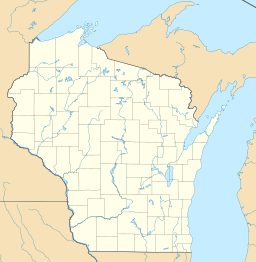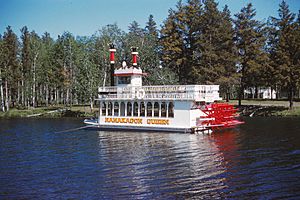Lake Hayward (Wisconsin) facts for kids
Quick facts for kids Lake Hayward |
|
|---|---|
| Location | Sawyer County, Wisconsin |
| Coordinates | 46°00′26″N 91°28′16″W / 46.0072°N 91.4711°W |
| Type | lake |
Lake Hayward is a lovely lake found in Sawyer County, Wisconsin. It gets its water from the Namekagon River. This river is a very important part of the Saint Croix National Scenic Riverway. This means the river and its surroundings are protected for their natural beauty.
Contents
Discover Lake Hayward's Features
Lake Hayward is known for its clear waters and beautiful natural setting. It is a popular spot for many outdoor activities. The lake is a great place to visit for fun and relaxation.
The Namekagon River Connection
The Namekagon River flows into Lake Hayward. This river is sometimes called "Wisconsin's Moving National Park." It is one of the cleanest rivers in the Midwest. The river helps keep Lake Hayward healthy. It brings fresh water and supports many plants and animals.
Part of a National Scenic Riverway
The Namekagon River is part of the Saint Croix National Scenic Riverway. This riverway protects over 200 miles of rivers. It is managed by the National Park Service. This protection helps keep the area wild and beautiful for everyone.
Fun at the Lumberjack Bowl
One of the most famous parts of Lake Hayward is the Lumberjack Bowl. This is a large bay on the lake. It is known worldwide for a special event.
Home of the Lumberjack World Championship
The Lumberjack Bowl is the main stage for the Lumberjack World Championship. This exciting event happens every summer. People from all over the world come to compete. They show off skills like log rolling, chopping, and sawing. It is a thrilling competition to watch.
What is Log Rolling?
Log rolling is a popular event at the championship. Two competitors stand on a floating log. They try to make the other person fall into the water. It takes great balance and quick feet.
Other Exciting Events
Besides log rolling, there are other cool events. These include speed climbing tall poles. There is also hot saw, where people cut through logs very fast. These events show the strength and skill of lumberjacks.
Wildlife and Nature Around the Lake
Lake Hayward is home to many different kinds of wildlife. The lake and its surrounding forests provide habitats for animals. You might see various birds, fish, and other creatures.
Common Fish Species
The lake is a good place for fishing. You might catch fish like walleye, bass, and northern pike. These fish are common in Wisconsin lakes. Fishing is a popular activity for visitors.
Birds and Other Animals
Many types of birds live near Lake Hayward. You might spot eagles, ospreys, and ducks. Deer, foxes, and other mammals also live in the nearby woods. It is a great place for nature lovers.
Activities for Visitors
Lake Hayward offers many fun things to do. Whether you like water sports or exploring nature, there is something for everyone.
Boating and Water Sports
Boating is very popular on Lake Hayward. You can go kayaking, canoeing, or paddleboarding. Motorboats are also allowed. It is a great way to enjoy the water and scenery.
Swimming and Picnics
On warm days, swimming in the lake is a favorite activity. There are often public access points for swimming. Many people also enjoy having picnics by the lake. It is a perfect spot for a family day out.
Exploring Nearby Trails
Around Lake Hayward, you can find trails for hiking and biking. These trails let you explore the beautiful forests. They offer a chance to see local plants and animals up close.
Protecting Lake Hayward
It is important to protect Lake Hayward and its natural environment. Everyone can help keep the lake clean and healthy.
Being Responsible Visitors
When visiting the lake, remember to take your trash with you. Do not leave anything behind. This helps keep the water clean for fish and other wildlife. It also keeps the area beautiful for future visitors.
Supporting Conservation Efforts
Local groups and organizations work to protect Lake Hayward. They help keep the water clean and manage the fish populations. Supporting these efforts helps ensure the lake stays healthy for many years.



